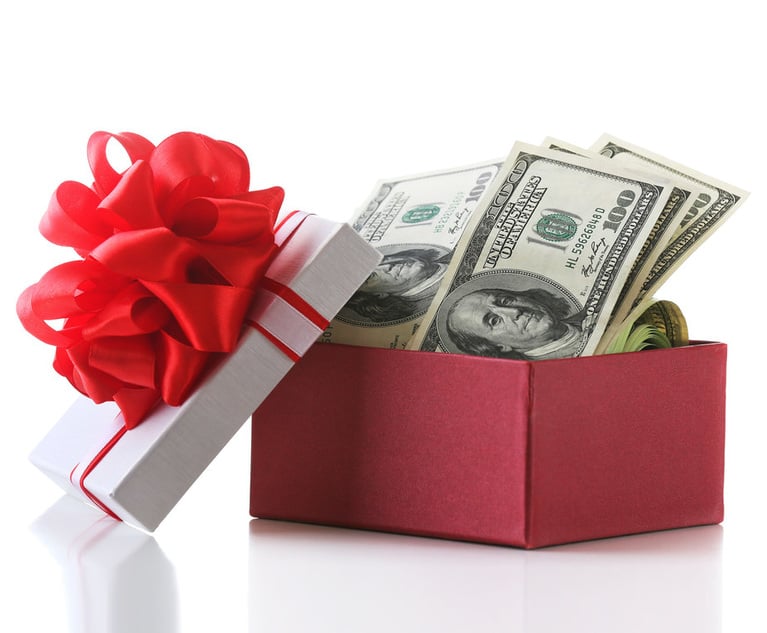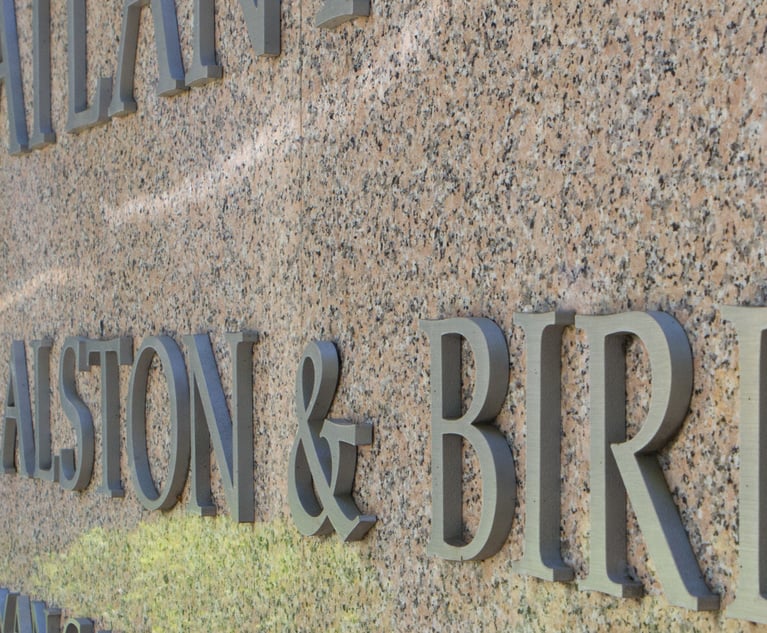 Image by Shutterstock
Image by ShutterstockBoutiques Aim to 'Blow the Lid Off' With Associate Bonuses
Nationwide, more boutique law firms are treating Cravath's bulging year-end bonuses as a floor, not a ceiling.
December 11, 2017 at 05:42 PM
5 minute read
With law firm bonus season in full swing, Susman Godfrey sent a powerful signal to current and future hires on Monday. The Houston-based firm announced that year-end bonuses for its 47 partnership-track associates would range from $45,000 to $170,000—and that two of its associates would receive bonuses totaling more than $220,000.
Beyond the six-figure thank you, the firm's management said the bonuses also serve as a message to top law students who may eventually decide between a future at Susman and a career at a bigger, full-service firm.
“We will match them on the salaries, but we will blow them out of the water when it comes to bonus time,” said Erica Harris, Susman Godfrey's recruiting partner.
“We definitely each year try to send the message that we want the best and you are going to be rewarded if you are the best,” Harris added.
Nationwide, other boutique law firms have also announced associate bonuses equaling or exceeding those offered at Cravath, Swaine & Moore, which traditionally sets the market scale for Big Law bonuses at top firms.
Last month Cravath announced that “virtually all” of its associates will receive a full year-end bonus. The firm's first-years can expect to take home a $15,000 bonus, with payouts ranging up to $100,000 for eighth-year associates. That amounts to total compensation of roughly $195,000 to $415,000 for the firm's young lawyers.
As other Am Law 100 firms have largely matched Cravath's bonus scale, some boutiques have offered even higher rewards.
John Hueston, a founding partner at Los Angeles boutique Hueston Hennigan, confirmed his firm is handing associates, who already earn salaries comparable to their Cravath peers, year-end bonuses equaling 30 to 50 percent of their salaries. (Those bonuses were first reported by Above the Law.)
The firm calculates bonuses partly on associates' length of service and performance, Hueston said. The firm, which has a 1:3 partner-to-associate ratio and 48 lawyers, also chips in 3 percent of associates' gross pay to their 401(k) retirement accounts.
“We want to reward their hard work. Our mission is to create an entrepreneurial spirit in the firm,” Hueston said. He noted Hueston Hennigan has issued such generous bonuses at the end of each of the three years since it began.
The firm's largesse gets plenty of trade-press attention and helps with recruiting, Hueston said. “We don't publish [the bonuses], but they get in the press. It's a tradition,” he said.
Beth Wilkinson, a former Paul, Weiss, Rifkind, Wharton & Garrison partner who co-founded Washington, D.C.'s Wilkinson Walsh + Eskovitz in February 2016, said her firm bases bonuses entirely on associates' length of service. Wilkinson Walsh gave its first-year associates $22,500 bonuses and its most senior associates $150,000 bonuses.
“We are delighted to recognize the extraordinary talents and efforts of our associates, who drive our success,” Wilkinson said in a statement.
At least two other boutiques reported that they would match Cravath's bonuses: Kaplan & Company, a boutique started by another former Paul Weiss woman partner, Roberta Kaplan, and Holwell Shuster & Goldberg, a firm founded by former U.S. District Judge Richard Holwell of the Southern District of New York and other White & Case alums.
|'Playing With the Big Boys'
Law firm consultants said boutiques that have the money for lavish bonuses see plenty of potential upside.
For starters, the bonuses cost the boutiques relatively little, particularly when compared to their profits. As a rule, boutiques have fewer associates per partner than traditional Big Law firms, so their equity partners' net income usually dwarfs the total cost of the bonuses, the consultants said.
“These firms have got the money. If they choose to invest it this way, it's no sweat for them,” said Kent Zimmermann, a legal consultant at the Zeughauser Group.
But what's relatively little cash for the boutiques' partners can represent game-changing sums for individual, often debt-burdened associates. “These bonuses are meaningful. When you're fresh out of law school, still paying big student loans, a 30 percent bonus is usually a big deal,” Zimmermann said.
The well-publicized bonuses also help the law firms when they recruit, as Susman Godfrey's Harris noted.
“It helps establish their credibility as being as top-drawer as any of the white-shoe firms,” said Janet Stanton of Adam Smith Esq. in New York.
The bonuses are not handed out defensively, she said. Associates are not demanding them. Instead, the firms are making a deliberate marketing decision and showing “they are playing with the Big Boys,” Stanton said.
Susman Godfrey's associate compensation news has drawn attention in the past. The firm jolted the market in 2016 when it hiked starting associate salaries to $190,000, and then this summer crammed another lure on its hiring hook: a $25,000 signing bonus.
Last week, Neal Manne, a co-managing partner at Susman Godfrey, predicted in an email that his firm's associate 2017 bonuses would “blow the lid off” the competition.
Did the forecast come true? So far Susman is the firm to beat. But with nearly three weeks still left in the year, its competitors still have a say in the matter.
UPDATE: Another boutique, New York's Dontzin Nagy & Fleissig, said Tuesday it will give its five associates year-end bonuses that top out at $185,000, with totals based on merit.
“We are an entrepreneurial law firm. We make bets on ourselves, and when we do well, we share our success throughout the firm,” Matthew Dontzin, the firm's founding partner, said in a statement.
This content has been archived. It is available through our partners, LexisNexis® and Bloomberg Law.
To view this content, please continue to their sites.
Not a Lexis Subscriber?
Subscribe Now
Not a Bloomberg Law Subscriber?
Subscribe Now
NOT FOR REPRINT
© 2025 ALM Global, LLC, All Rights Reserved. Request academic re-use from www.copyright.com. All other uses, submit a request to [email protected]. For more information visit Asset & Logo Licensing.
You Might Like
View All

Trending Stories
Who Got The Work
Michael G. Bongiorno, Andrew Scott Dulberg and Elizabeth E. Driscoll from Wilmer Cutler Pickering Hale and Dorr have stepped in to represent Symbotic Inc., an A.I.-enabled technology platform that focuses on increasing supply chain efficiency, and other defendants in a pending shareholder derivative lawsuit. The case, filed Oct. 2 in Massachusetts District Court by the Brown Law Firm on behalf of Stephen Austen, accuses certain officers and directors of misleading investors in regard to Symbotic's potential for margin growth by failing to disclose that the company was not equipped to timely deploy its systems or manage expenses through project delays. The case, assigned to U.S. District Judge Nathaniel M. Gorton, is 1:24-cv-12522, Austen v. Cohen et al.
Who Got The Work
Edmund Polubinski and Marie Killmond of Davis Polk & Wardwell have entered appearances for data platform software development company MongoDB and other defendants in a pending shareholder derivative lawsuit. The action, filed Oct. 7 in New York Southern District Court by the Brown Law Firm, accuses the company's directors and/or officers of falsely expressing confidence in the company’s restructuring of its sales incentive plan and downplaying the severity of decreases in its upfront commitments. The case is 1:24-cv-07594, Roy v. Ittycheria et al.
Who Got The Work
Amy O. Bruchs and Kurt F. Ellison of Michael Best & Friedrich have entered appearances for Epic Systems Corp. in a pending employment discrimination lawsuit. The suit was filed Sept. 7 in Wisconsin Western District Court by Levine Eisberner LLC and Siri & Glimstad on behalf of a project manager who claims that he was wrongfully terminated after applying for a religious exemption to the defendant's COVID-19 vaccine mandate. The case, assigned to U.S. Magistrate Judge Anita Marie Boor, is 3:24-cv-00630, Secker, Nathan v. Epic Systems Corporation.
Who Got The Work
David X. Sullivan, Thomas J. Finn and Gregory A. Hall from McCarter & English have entered appearances for Sunrun Installation Services in a pending civil rights lawsuit. The complaint was filed Sept. 4 in Connecticut District Court by attorney Robert M. Berke on behalf of former employee George Edward Steins, who was arrested and charged with employing an unregistered home improvement salesperson. The complaint alleges that had Sunrun informed the Connecticut Department of Consumer Protection that the plaintiff's employment had ended in 2017 and that he no longer held Sunrun's home improvement contractor license, he would not have been hit with charges, which were dismissed in May 2024. The case, assigned to U.S. District Judge Jeffrey A. Meyer, is 3:24-cv-01423, Steins v. Sunrun, Inc. et al.
Who Got The Work
Greenberg Traurig shareholder Joshua L. Raskin has entered an appearance for boohoo.com UK Ltd. in a pending patent infringement lawsuit. The suit, filed Sept. 3 in Texas Eastern District Court by Rozier Hardt McDonough on behalf of Alto Dynamics, asserts five patents related to an online shopping platform. The case, assigned to U.S. District Judge Rodney Gilstrap, is 2:24-cv-00719, Alto Dynamics, LLC v. boohoo.com UK Limited.
Featured Firms
Law Offices of Gary Martin Hays & Associates, P.C.
(470) 294-1674
Law Offices of Mark E. Salomone
(857) 444-6468
Smith & Hassler
(713) 739-1250











